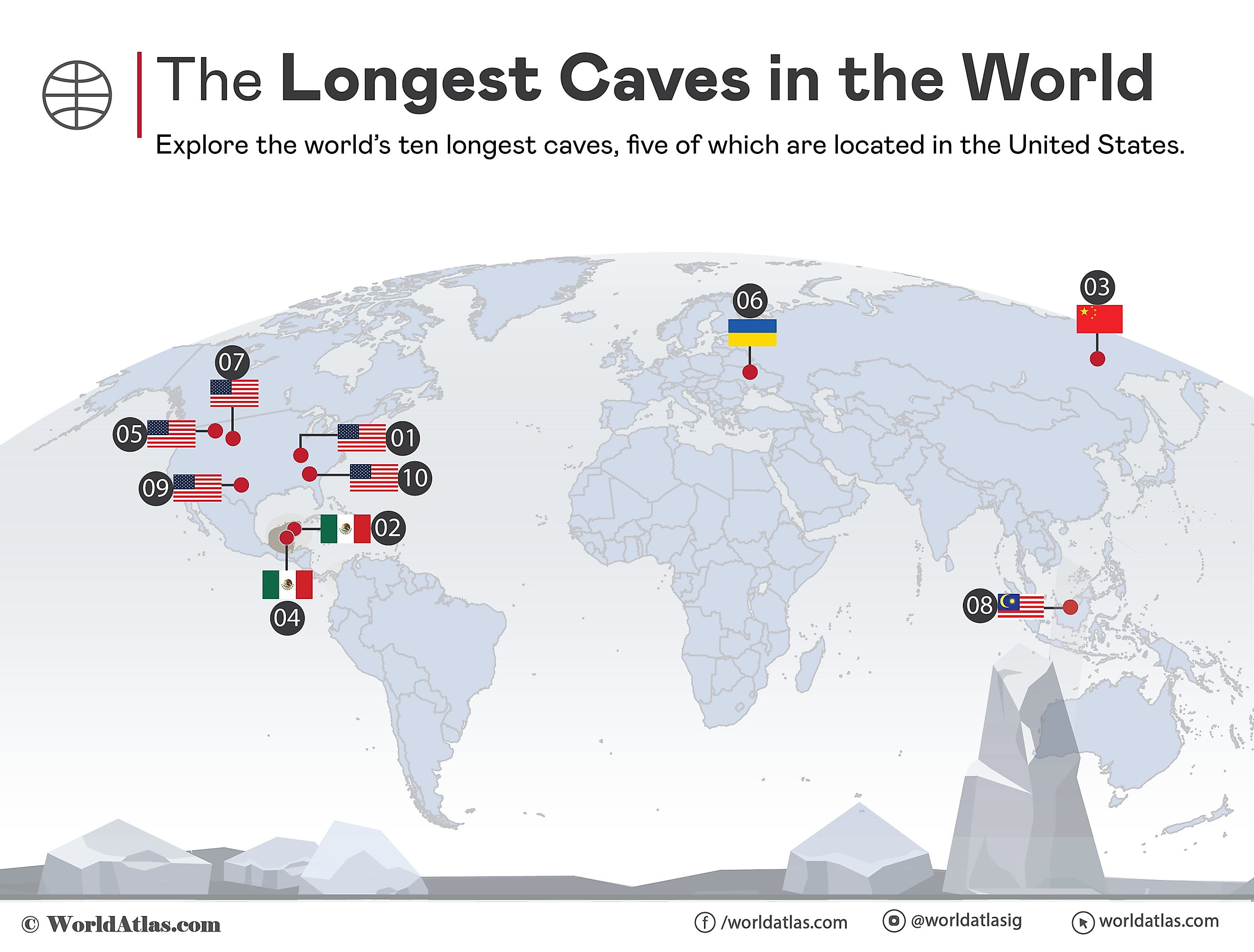
The Longest Caves in the World
A cave or cavern refers to a natural opening on the Earth’s surface that extends beyond the light zone and has a height and width that allows at least a single person to enter by crawling. Ranging widely in size, caves are formed by varied geological processes, and depending on their location and mode of formation, they are classified into different types. The longest caves in the world are found in areas with karst landforms whose rocks dissolve quickly. The highest number of such long caves are seen in southern Kentucky’s Pennyroyal Plateau, the Black Hills of South Dakota, and Mexico’s Yucatan Peninsula. The following article discusses the ten longest caves in the world.
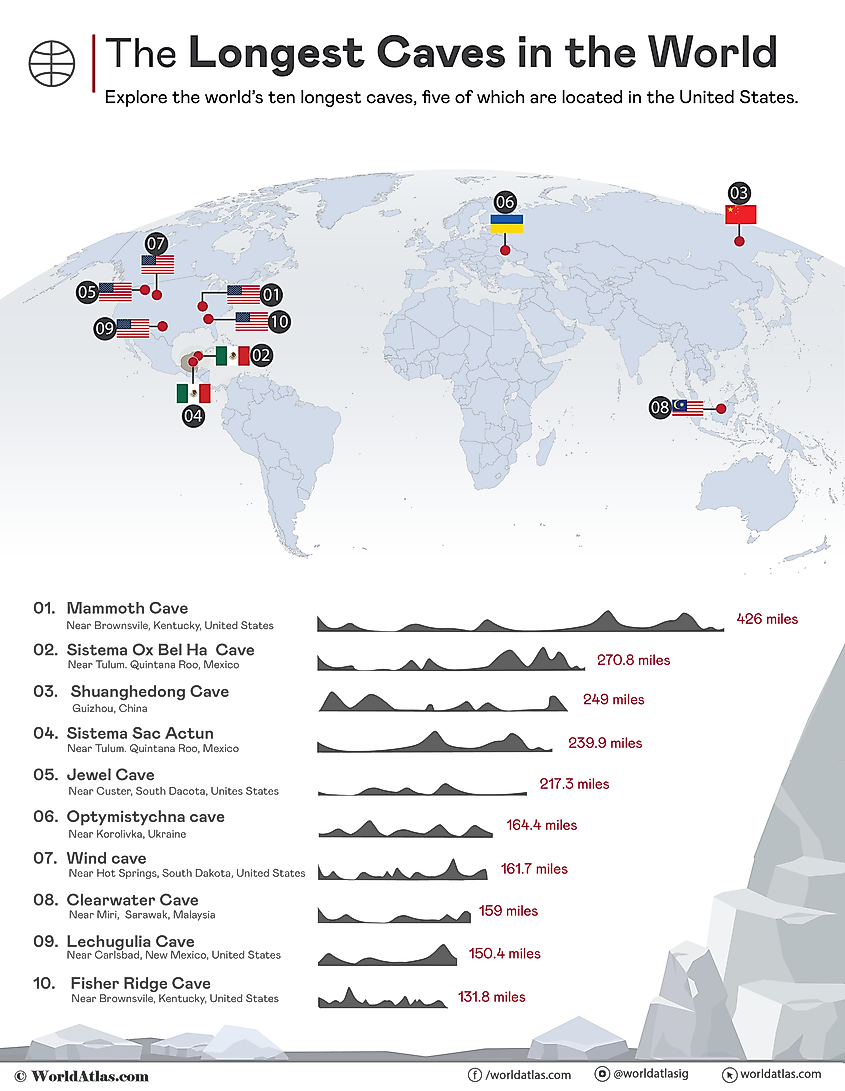
Mammoth Cave – 426.0 mi
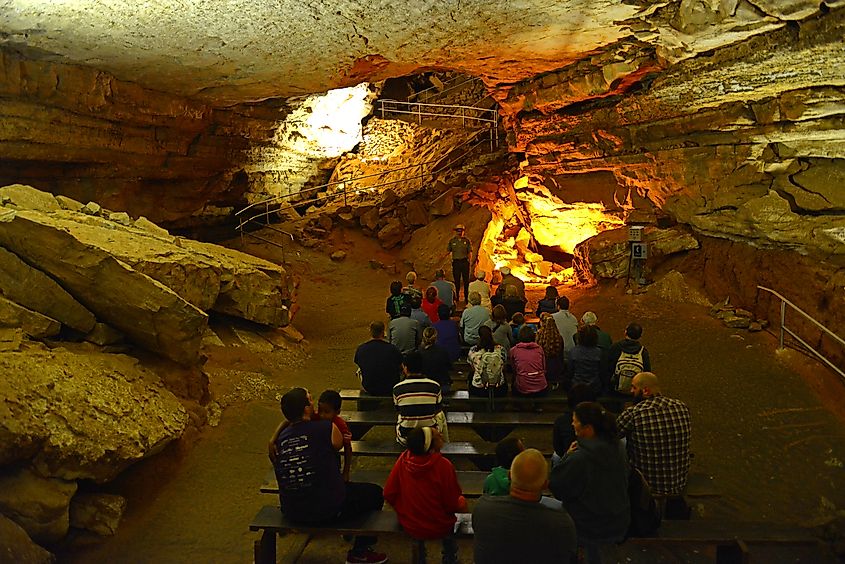
Located in the Green River Valley and rolling hills of south-central Kentucky, Mammoth Cave National Park preserves Mammoth Cave, the world’s longest-known cave system with over 426 miles of surveyed passageways. Two layers of rocks underline the national park’s hilly woodlands: the lower Mississippian-aged limestone strata capped by a layer of sandstone. The above sandstone layer contains leaks at places referred to as sinkholes, from which surface water continuously moves underground, leading to the dissolution of the limestone and the formation of caverns. The Mammoth Cave features large horizontal passages with massive chambers, vertical shafts, stalactites, stalagmites, gypsum flowers, gypsum needles, etc. Mammoth Cave is home to over 130 species of subterranean faunae, of which 14 species of troglobites and troglophiles are known to exclusively exist here.
In the early 19th and 20th centuries, several Native American remains, including mummified bodies possibly of pre-Columbian origin, were recovered from Mammoth Cave and other adjacent caves in the region. Over the years, the entire region developed into a popular tourist destination. At present, access to the Mammoth Cave is strictly controlled, and visitors are mainly restricted to 10 miles of developed passageways. In addition to cave visits, canoeing, hiking, fishing, wildlife viewing, and camping are some well-known activities offered by the Mammoth Cave National Park.
Sistema Ox Bel Ha – 270.8 mi
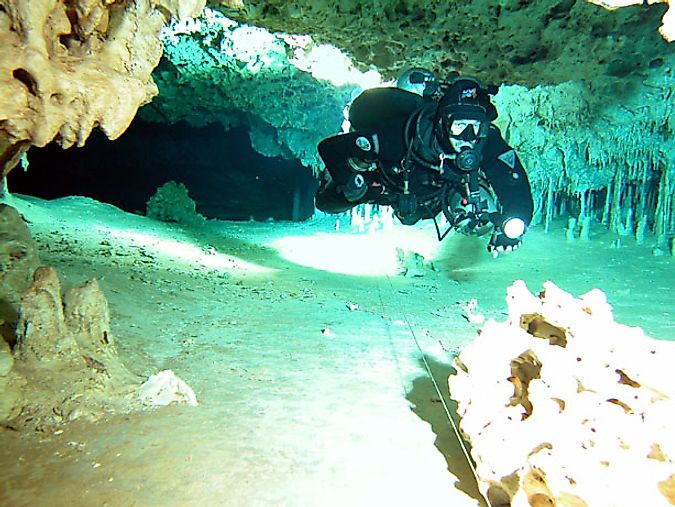
Sistema Ox Bel Ha or the Ox Bel Ha system, which means “Three Paths of Water” in the native Yucatec Maya language, is the world’s longest explored underwater cave and the 2nd-longest cave system having a total surveyed length of 270.8 miles of underwater passages. This complex system of limestone caverns and passageways is located immediately south of the Mayan town of Tulum in Mexico’s Quintana Roo state, close to the Sian Ka’an Biosphere Reserve. A team of experienced cave divers first discovered and explored the Sistema Ox Bel Ha cave system in 1996.
Ox Bel Ha encompasses many interconnected underwater cave systems, having over 150 cenotes, including Jailhouse cenote, cenote Naharon, Cenote Corazon del Paraiso o Chupich, etc. The principal feature of this cave system located close to the Caribbean Sea is that a higher freshwater layer flows at the top of a near-static-salt-water layer. This results in the formation of a halocline, which occurs at different depths. A change in water level due to daily tides is also clearly visible in several cenotes. As the freshwater moves closer to the ocean, the low flow that characterizes the cave on this side of the Yucatan Peninsula intensifies greatly. Therefore, advanced cave diving techniques are necessary for cave divers who wish to dive through the labyrinth of this cave system.
Three prehistoric human remains were discovered within Sistema Ox Bel Ha’s Naranjal subsystem. A skeleton of an 18 to 20-year-old woman and a 44 to 50-year-old woman were found around 1,207 ft and 1.2 mi away from the Jailhouse cenote entrance, respectively. The remains of a 40 to 50-year-old man were also discovered in Muknal Cave, which is a part of this Naranjal subsystem. A detailed analysis of these skeletons revealed that Sistema Ox Bel Ha was most likely used as a significant burial site. In addition, the Sistema Ox Bel Ha cave system is home to numerous subterranean life forms that have perfectly adapted to the cave's eternal darkness and unique conditions. The presence of these rare and endemic species has made Sistema Ox Bel Ha a crucial hotspot for scientific research and conservation activities.
Shuanghedong Cave Network – 249.0 mi
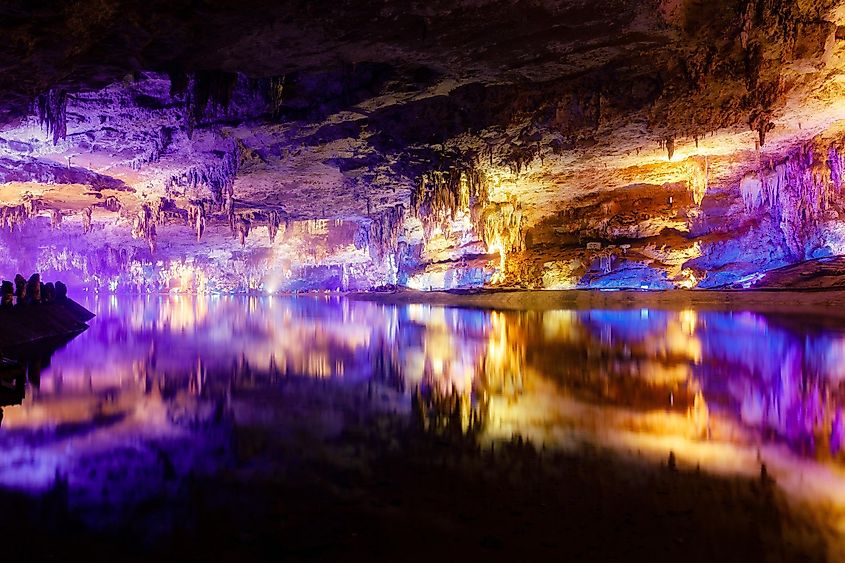
Located close to Suiyang County’s Wenquan town in China’s Guizhou province is the Shuanghedong Cave, Asia’s and China’s longest as well as the world’s 3rd-longest cave with a total length of about 249.0 mi. Forming a part of the Suiyang Shuanghedong National Geopark, this cave features about 105 entrances, several waterfalls, and underground rivers that serve as crucial habitats for cave shrimp, blind fish, tadpoles, salamanders, leeches, spiders, and bats. The Shuanghedong Cave network was first discovered in 1987, and since then, about 20 expeditions have been conducted by exploration teams from France and Japan. Recent laser mapping has also revealed that the cave is more extensive than initially expected. This cave network is tourist-friendly, and entry is allowed after a safety briefing at the Suiyang Shuanghedong National Geopark.
Sistema Sac Actun/ Sistema Dos Ojos – 239.9 mi
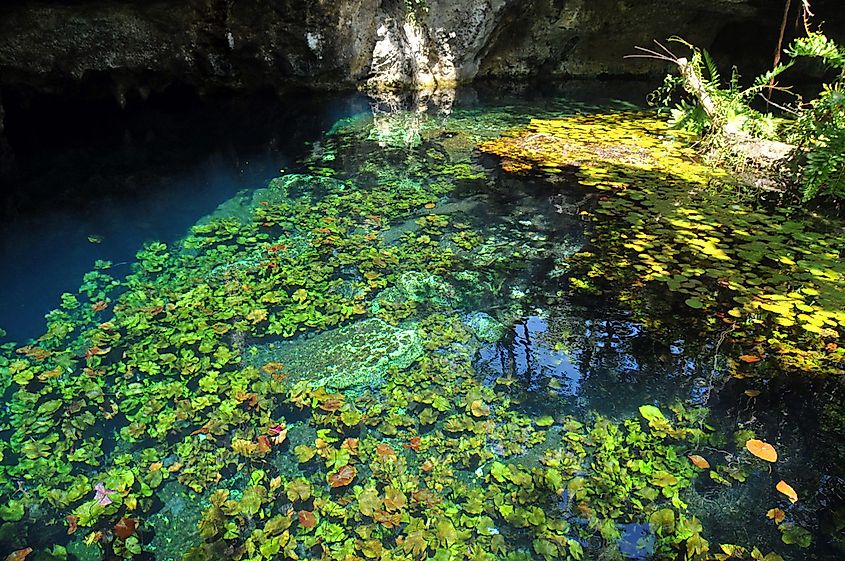
Sistema Sac Actun, or the Sac Actun system, which means “White Cave System” in the native Yucatec Maya language, is the world’s 4th-longest cave system with a total length of 239.9 mi. The discovery of Sistema Sac Actun’s connection with the adjacent Sistema Dos Ojos underwater cave complex in 2018 made it the world’s 2nd-longest underwater cave system. This extensive underwater cave system is located to the northeast of the Mexican state of Quintana Roo along the Yucatan Peninsula’s Caribbean coast on a sedimentary platform of Mesozoic and Cenozoic rocks. The Sac Actun cave system’s coastal sections are characterized by low horizontal tunnels forming mazes parallel to the coast and rudimentary conduits broken by fracture-controlled rooms. Access to the Sac Actun cave system is provided by multiple cenotes, such as Cenote Sac Actum, Cenote Dos Ojos, Cenote the Pit, etc., that dot the area. Over the years, teams of scientists and explorers have studied several miles of this cave system and discovered various archaeological and paleontological remains. For those who wish to explore Sac Actun, hire a local expert scuba guide having detailed knowledge about the different routes of this cave system.
Jewel Cave – 217.3 mi
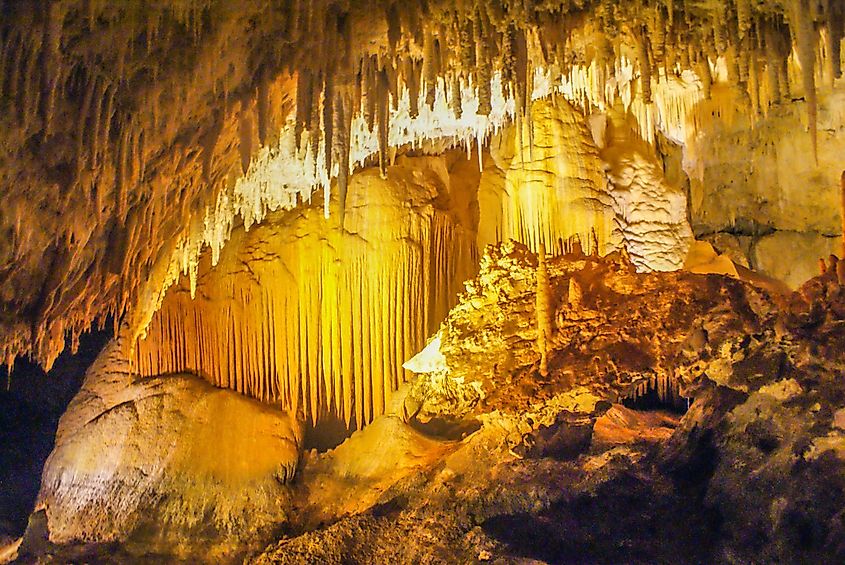
The Jewel Cave National Monument, placed approximately 13 miles west of Custer in the Black Hills of southwestern South Dakota, preserves Jewel Cave, the world’s 5th-longest cave with 217.32 miles of mapped passageways. Geological studies have revealed that a significant portion of the cave was formed within the Mississippian Pahasapa Limestone, deposited about 350 million years ago. The Jewel Cave features a succession of chambers joined by narrow passages. The cave is noted for its magnificent speleothems, including sparkling jewel-like calcite crystals or spar, stalactites, flowstone, frostwork, helictites, hydromagnesite balloon, etc. In addition, the Jewel Cave is also home to about 9 species of bats, among which 5 species are permanent residents. The ponderosa pine forest above the cave surface is inhabited by different fauna like elk, coyotes, white-tailed deer, and numerous avian species.
In 1900, two local prospectors, Frank and Albert Michaud, first discovered and explored the Jewel Cave. The Michaud brothers tried to capitalize on their discovery and opened the cave as a tourist attraction. However, even though their attempt was unsuccessful, President Theodore Roosevelt designated the Jewel Cave a National Monument on February 7, 1908. Systematic exploration of the passageways began only in the late 1950s. The National Park Service currently offers three tours to the Jewel Cave all year round: the hour-long scenic tour, the lantern-guided historic tour, and a four-hour-long wild caving tour.
Optymistychna Cave – 164.4 mi
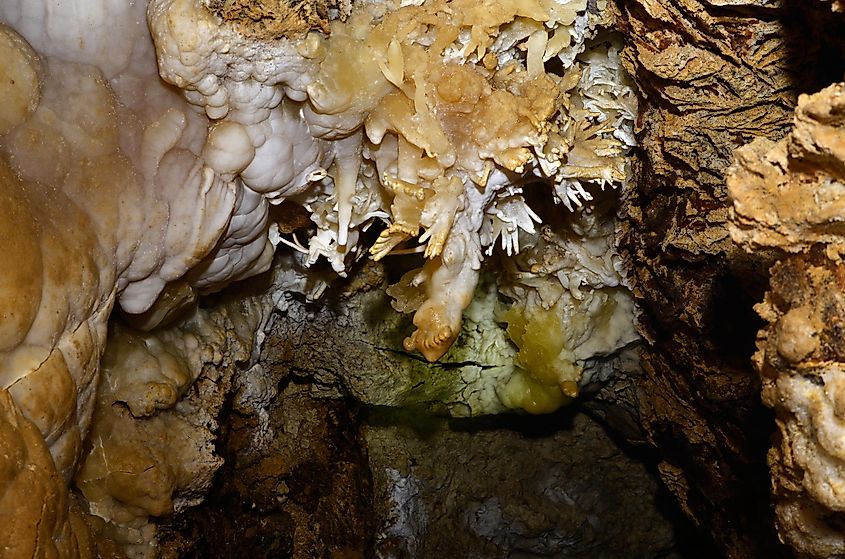
Also referred to as Peschtschera Optimistitscheskaya in the native Ukrainian language, Optymistychna Cave, with a total of 164.4 miles of mapped passageways, is Eurasia’s longest, and the world’s 6th-longest cave. Located close to Korolivka village in Chortkiv Raion within western Ukraine’s Ternopil Oblast, Optymistychna is also the world’s longest gypsum cave. The entire cave network lies underneath an area of about 2 sq. km in less than 98ft thick gypsum layer belonging to the Neogene period. Optymistychna is sometimes called a ‘maze cave,’ where the small cave passages form a dense network on several levels that are often clogged with mud. The cave’s gypsum bed is capped by a limestone layer that leaks into the cave through erosion, forming the calcite speleothems.
On May 8, 1966, a group of Lviv speleologists led by Myron Savchyn of “Cyclope,” the Lviv speleological club, first discovered the Optymistychna cave complex. Since then, there have been several expeditions to the cave. However, over the years, exploration activities have slowed down, and extremely few surveys are currently carried out. Optymistychna Cave was recognized as a “Natural Wonder of Ukraine” in 2008.
Wind Cave – 161.7 mi
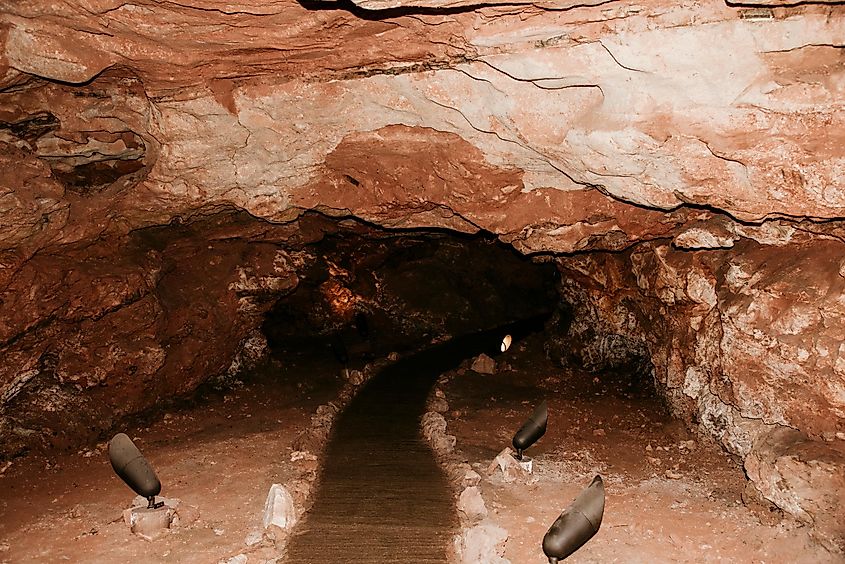
The first cave to be designated as a national park, the Wind Cave National Park, located about 10 miles north of Hot Springs in the western portion of South Dakota, contains Wind Cave, the United States’ 3rd-longest and the world’s 7th-longest cave with 161.7 miles of explored passageways. Wind Cave is noted for its two unusual features: the reversible wind that continually flows in and out of the cave, equalizing the atmospheric pressure of the cave and the outside air; and an outstanding display of boxwork and frostwork calcite formations. Wind Cave is also considered the world’s densest cave system, with the greatest passage volume per cubic mile.
The Wind Cave National Park also includes the country’s largest remaining natural mixed-grass prairie that serves as an essential habitat for various native wildlife species such as bison, pronghorn, coyotes, elk, prairie dogs, raccoons, black-footed ferret, whooping crane, and many more. It is believed that the indigenous Native American tribes who lived in the area knew about an opening and regarded it as sacred for centuries. However, the first recorded discovery of the Wind Cave was by Jesse and Tom Bingham, who were attracted to the cave’s only natural opening by a loud whistling noise. From February 1892 onwards, the cave was opened for tourists. At present, various scheduled ranger-led tours to the Wind Cave are offered all year round.
Clearwater Cave System – 159.0 mi
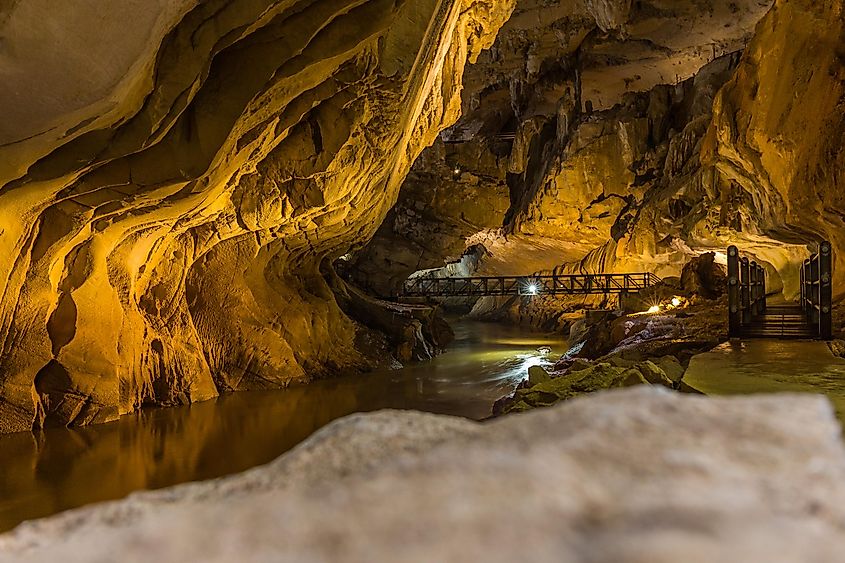
Also known as Gua Air Jernih in the native Malay language, the Clearwater Cave System, located in Malaysia’s Gunung Mulu National Park, is the world’s 8th-longest cave, Southeast Asia’s most extended cave system, as well as one of the world’s largest interconnected cave systems by volume. The Clearwater Cave System is situated mainly beneath the western margins of the limestone mountain Gunung Api between the Cave of the Winds and Melinau Gorge. The first exploration of the Clearwater Cave System took place during the Royal Geographical Society Mulu Sarawak Expedition of 1977/78 when about 15 miles of cave passages were surveyed. Over the years, the Mulu Caves Project has conducted several expeditions that have increased the explored length of the cave.
It is interesting to note that the Clearwater Cave has an underground river, a portion of which is navigable by boat. One can reach the Clearwater Cave by trekking along a 2.48-mile-long nature trail or traveling by a long boat along the Melinau River. About 200 steps lead up through the forest to the cave’s mouth. A crystal-clear pool at the base of the steps offers visitors opportunities to take a refreshing dip.
Lechuguilla Cave – 150.4 mi
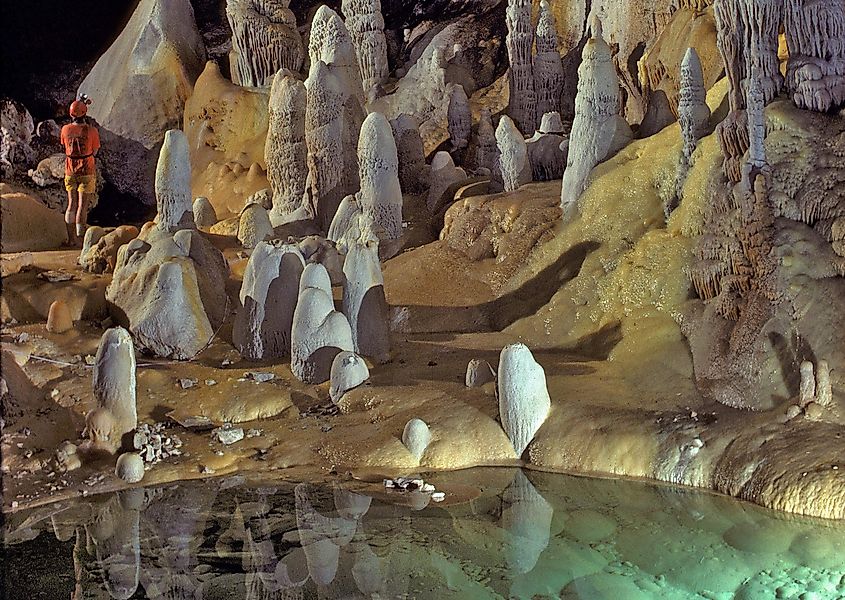
The remote desert terrain of the Guadalupe Mountains in southeastern New Mexico’s Carlsbad Caverns National Park is home to the 150.4-mile-long Lechuguilla Cave, the world’s 9th-longest explored cave and the continental United States’s 2nd-deepest cave, reaching a depth of about 1,604 ft below the surface. Famed for its uncommon geology, stunning formations, and unspoiled condition, the cave has been named after the canyon through which it can be entered that, in turn, is named after the native plant species – Agave lechuguilla. Lechuguilla Cave contains a wide variety of rare carbonate and sulfate speleothems, such as hydromagnesite balloons, 20 ft gypsum chandeliers, 15 ft soda straws, lemon-yellow sulfur deposits, cave pearls, etc.
This deep hypogenic cave was formed by the oxidation of hydrogen sulfide from hydrocarbons in the adjacent Delaware Basin. The hydrogen sulfide was absorbed into oxygenated water on bedrock surfaces and oxidized to sulfur and sulfuric acid. The acidified groundwater then infiltrated upward into the Capitan Formation’s carbonate rock, forming the Lechuguilla Cave. The reduction in aquifer level after the cave formation made it hydrologically isolated from phreatic groundwater. Moreover, the impermeable rock of the Yates Formation that overlies the Capitan Formation also makes the cave hydrologically isolated from above. Studies have reported the presence of rare chemolithoautotrophic bacteria in the cave. These bacteria are believed to feed on minerals (sulfur, iron, etc.), helping to enlarge the cave and determine the shape of the uncommon speleothems.
Until 1986, the Lechuguilla cave was considered an insignificant historic site at the Carlsbad Caverns National Park’s backcountry. The entrance passages were mined for small quantities of bat guano, while the cave’s 90 ft entrance pit named Misery Hole led to 400 ft of dry, dead-end passages. In 1984, a group of cavers from Colorado Grotto led by Dave Allured started digging, and extensive walking passages were successfully discovered on May 26, 1986. Since then, explorers have mapped over several miles of passages. However, currently, as a crucial conservation measure, access to the Lechuguilla Cave is restricted to only NPS-approved scientific researchers and exploration teams.
Fisher Ridge Cave System – 131.8 mi
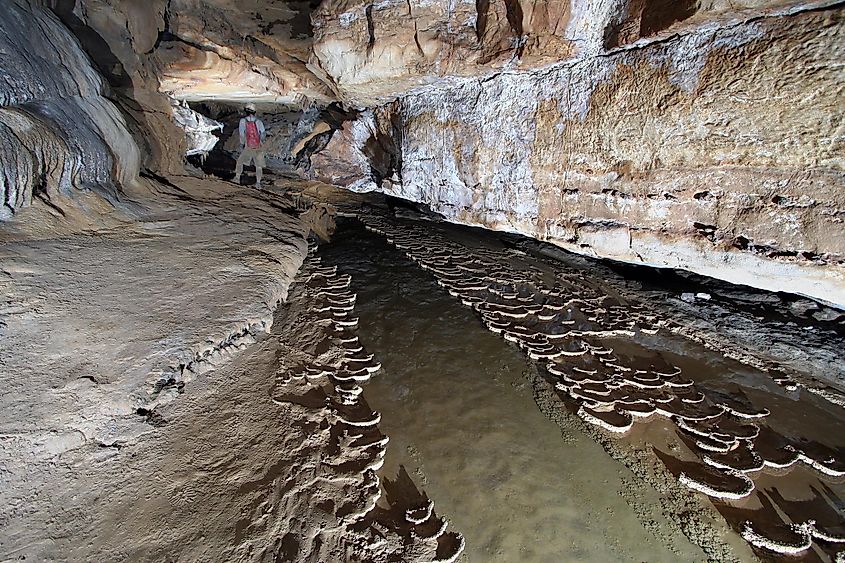
The world’s 10th-longest and United States’s 5th-longest cave, the Fisher Ridge Cave System is a 131.8-mile-long cave system located in Kentucky’s Hart County close to the Mammoth Cave National Park. It is believed that the Archaic Native Americans were the earliest visitors to the Fisher Ridge Cave System. In January 1981, the cave was rediscovered by a group of Michigan cavers belonging to the Detroit Urban Grotto of the National Speleological Society.
The Fisher Ridge Cave System comprises two massive segments linked by a 1000-foot-long crawl in between. The cave’s Northtown Ridge portion is about 80 miles long and includes numerous sizeable dry tunnels similar to the nearby spectacular and storied Mammoth Cave system. The 50-mile-long Fisher Ridge section contains many active streams and two principal mid-level trunk sections. An uninterrupted set of deserted trunk passages spans about 5.5 miles, stretching from one end of the cave to another.
However, despite a separation of only 600ft between the closest cave passages, it is yet to be ascertained whether a connection exists between the Fisher Ridge Cave System and the Mammoth Cave system. The closest connection between the two cave systems is situated high in the ridges between the discrete passages, which is most likely not favorable for any connection. Moreover, a drainage divide exists between a significant part of these two cave systems. Therefore, even if a link exists, it is thought to be located quite deep in the active base-level streams. The Fisher Ridge and Mammoth Cave explorers have been conducting continuous explorations in search of a connection or favorable passageways between the two cave systems.
Being one of the most awe-inspiring formations on the Blue Planet, caves have evoked an immense interest in mankind through centuries. These delicate natural resources house an array of archeological as well as paleontological records that provide a glimpse into the Earth’s evolutionary past. Therefore, exploring such a subterranean cavern opens a completely new world to researchers and enthusiastic travelers. So, whether you are a pro spelunker or an avid adventurer, you must not miss a chance to visit any of the world’s longest caves and gather memories of a lifetime.
The Longest Caves In The World
| Rank | Cave System | Length (Miles) | Location |
|---|---|---|---|
| 1 | Mammoth Cave | 426 | near Brownsville, Kentucky, United States |
| 2 | Sistema Ox Bel Ha | 270.8 | near Tulum, Quintana Roo, Mexico |
| 3 | Shuanghedong Cave Network | 249 | Guizhou, China |
| 4 | Sistema Sac Actun / Sistema Dos Ojos | 239.9 | near Tulum, Quintana Roo, Mexico |
| 5 | Jewel Cave | 217.3 | near Custer, South Dakota, United States |
| 6 | Optymistychna Cave | 164.4 | near Korolivka, Ukraine |
| 7 | Wind Cave | 161.7 | near Hot Springs, South Dakota, United States |
| 8 | Clearwater Cave System | 159 | near Miri, Sarawak, Malaysia |
| 9 | Lechuguilla Cave | 150.4 | near Carlsbad, New Mexico, United States |
| 10 | Fisher Ridge Cave System | 131.8 | near Brownsville, Kentucky, United States |











